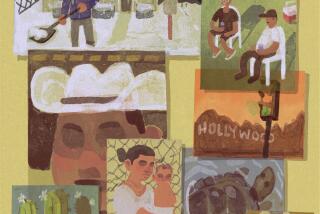Italy in the West : Display at the Gene Autry museum looks at immigrants’ contribution to the growth of the United States starting in the 19th Century.
- Share via
Film director Sergio Leone and his spaghetti Westerns notwithstanding, we don’t readily associate Italians with the American West. But, like people from all parts of the United States and the world, Italians began establishing communities in the West and contributing to its development and culture in the 19th Century.
In 1989 and 1990, the Library of Congress’ American Folklife Center conducted a study on Italian-Americans in the West. Researchers taped interviews with Italian-Americans in communities where they have long been involved with the distinct regional economies. Among the communities in the study were San Pedro and Gilroy, in Northern California.
The researchers generated 300 hours of interviews, 24,000 photographs, 35 hours of video documenting aspects of the interviewees’ lives and 2,000 pages of field notes. From this effort has come the exhibit “Old Ties, New Attachments: Italian-American Folklife in the West,” on view at the Gene Autry Western Heritage Museum.
Using information and actual excerpts from those interviews, as well as photographs and family heirlooms, the show presents a look at Italian-American heritage and customs in the West through the eyes of early settlers’ descendants.
“The show was developed from the point of view of the folklorist,” said Autry museum curator James Nottage. “It is full of treasures in the form of everyday objects of life that express traditions and folkways. We were interested in the subject because of our interest in the variety of cultures and ethnic groups in the West.”
Organized into three sections--”Family,” “Work” and “Ties and Attachments”--each area contains a “Story Station,” a touch-screen computer that allows visitors to see, in still photographs, several people interviewed and listen to their stories.
Most of the stories in the “Family” section are about the older generation, how they left Italy for America to encounter a strange language and a sometimes hostile culture. According to the video’s narrator, some of the family stories “are humorous. Some are heroic. Most are true.”
Displays in the “Family” area spotlight items in home kitchens, gardens and shrines that reflect Western Italian-American family history.
Presentations within the “Work” section reveal that Western Italian-Americans have a history in everything from ranching to winemaking, fishing to farming. In Walla Walla, Wash., they became known for their sweet onions. They developed mining and ranching communities in central and eastern Nevada and established canneries in California. Between 1880 and 1940, vegetable, fruit and fish canneries in the West provided work for new Italian immigrants, giving them their start here.
In California in the first half of this century, names such as Rialto, Orosi and De Marco were proudly displayed on citrus crate labels. Italian fishermen came to San Pedro in three waves between 1910 and 1960. The descendants of those men who came in the first two waves recalled San Pedro’s heyday in the 1940s when “you could walk on the fish.” During that era, 500 boats brought in 10,000 tons of sardines and 3,000 tons of other fish each day.
“Ties and Attachments” explores the transformation of Italians to Italian-Americans and looks at what is Italian and what is American in their lives. One display panel shows how immigrants Anglicized their surnames. The “Story Station” presents adults singing the American cowboy songs and the Italian pop tunes they sang while growing up in Utah.
Several items convey the importance of Christopher Columbus to Italian-American communities, including a painting of a man who portrayed him in Columbus Day parades in San Francisco from 1957 to 1988, and a Columbus Day parade float.
“For the Native American, Columbus is a symbol of loss and cultural devastation. For Italian-Americans, he’s a cultural hero,” Nottage said.
There is also a map of Italy that identifies areas within the country and that can be used, as one mother did, to show her young son “where Daddy’s family is from.”
“One of the neat things about a show like this is it can be very much alive,” Nottage said.
Where and When What: “Old Ties, New Attachments: Italian-American Folklife in the West” at the Gene Autry Western Heritage Museum in Griffith Park, 4700 Western Heritage Way. Hours: 10 a.m. to 5 p.m. daily except Monday. Through May 31. Price: Adults $6, senior citizens and students with valid identification $4.50, children ages 2 through 12, $2.50. Call: (213) 667-2000.
More to Read
The biggest entertainment stories
Get our big stories about Hollywood, film, television, music, arts, culture and more right in your inbox as soon as they publish.
You may occasionally receive promotional content from the Los Angeles Times.










